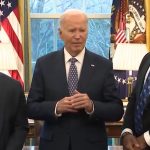Justin Sullivan/Getty Images
- When President Donald Trump started posting misinformation about the 2020 election, Twitter and Facebook’s election integrity policies were put to the test.
- Misinformation experts told Business Insider that Twitter did a better job of tackling the posts, mainly because it placed restrictions hindering other users from spreading Trump’s claims.
- Facebook’s messages on Trump’s posts were often more detailed, one expert said, but the platform’s lack of sharing restrictions means “false information can still quickly spread.”
- Another expert said the platforms’ obligation to respond to the president’s tweets will mean they can no longer claim to be “neutral actors.”
- Visit Business Insider’s homepage for more stories.
As Election Day drew to a close on Tuesday, the inevitable Trump tweets started.
The president’s social media posts throughout the evening and into Wednesday posed a challenge for Facebook and Twitter, as some of them contained premature claims of victory — both in individual states and the election overall — and allegations of election fraud, made without evidence.
This tested both social media companies’ policies about election integrity. Twitter ended up labeling five of the president’s tweets over Tuesday and Wednesday as “misleading.” Facebook attached eight specific information cards to posts from Trump, and reminded users that votes were still being counted next to other posts from both the president and political officials.
There were some key differences in exactly how the platforms sanctioned posts that broke their respective policies on election integrity. And according to three misinformation experts who spoke to Business Insider, Twitter has done a better job of policing Trump’s wild claims of premature victory and election fraud than Facebook.
Twitter wins points for taking action in May and for limiting spread
“Twitter has been, as they were pre-election, more likely to quickly apply labels on Trump tweets falsely claiming victory and/or fraud, as well as to set up significant friction in their reach,” said Shannon McGregor, an assistant professor at the Hussman School of Journalism and Media.
Twitter first began to apply restrictions and fact-checks to Trump’s back in May. On May 26 the platform applied two fact-check labels to tweets from Trump that falsely claimed mail-in ballots cast in California would be “substantially fraudulent.”
Three out of four experts Business Insider spoke to pointed out that Twitter took the extra step of not only labelling Trump’s tweets, but also placing restrictions on how they could be shared.
Any tweets from Trump that violate the company’s election integrity policy cannot be liked, retweeted, or replied to — although people are allowed to “quote” retweet, i.e. they can retweet it so long as they add their own comment.
“Generally, I would say that Twitter has been more forthright in its approach than Facebook, both in terms of when they first began to fact-check and label the President’s false or misleading claims (in May), as well as in how they have labelled these and restricted their amplification,” said Felix Simon, a political communications expert at the Oxford Internet Institute, told Business Insider.
“Facebook, on the other hand, has been more timid in this regard and generally could have done more, especially with a view to stopping the spread of Trump’s false claim that the election was being stolen from him,” he added.
Here is a side-by-side comparison of how Twitter and Facebook took action against identical posts from Trump:
Twitter/Facebook
“I’ve been fairly impressed with Twitter’s follow-through,” said Lisa Fazio, assistant professor of psychology and human development at Vanderbilt University. She said that although Facebook’s information labels tend to be more detailed than Twitter’s, the fact it places no sharing restrictions means “false information can still quickly spread on the platform.”
Aleksi Knuutila, an anthropologist and data scientist at the Oxford Internet Institute, said that just because Trump’s tweets can’t spread on Twitter, doesn’t mean they aren’t spread elsewhere.
“Labelling Trump’s tweets probably doesn’t do much to reduce their audience. After all, whatever he says is often repeated by traditional media outlets in detail,” he said.
“It might, however, change the way that people see the information. Research shows that warning labels placed on misinformation do make users more sceptical about it,” he added.
How well did they do overall?
Felix Simon said he was generally satisfied with how the platforms handled Trump’s posts.
“All in all, both companies have come a long way since 2016 and I think this has to be acknowledged, although we should not forget that it took enormous efforts from activists, academics, journalists, and a handful of policymakers and other actors to push them to finally take more responsibility,” he said.
“While it’s too early to draw final conclusions, the behaviour we’ve seen so far from social media platforms and news media alike has been better than many feared. We can only hope that it stays this way while the outcome of the election hangs in the balance,” he said.
McGregor was less impressed by the way the platforms reacted. “They’ve been pretty consistent along the lines we expected, which is to say — not great,” she said.
Knuutlia said there were some “clear positives” in the way the platforms navigated Election Day — but said the long-lasting effect could be to force them into admitting they make editorial decisions.
“Whatever Facebook and Twitter do in this situation, somebody would accuse them of being partisan. This election was the final nail in the coffin for the idea that platforms are neutral actors,” he said.
He also warned that the platforms offer plenty of room for other, less official sources of misinformation to circulate. “There’s definitely much more clearly false information circulating than the platforms can deal with,” he said.
Business Insider has contacted both Facebook and Twitter for comment.
Powered by WPeMatico






